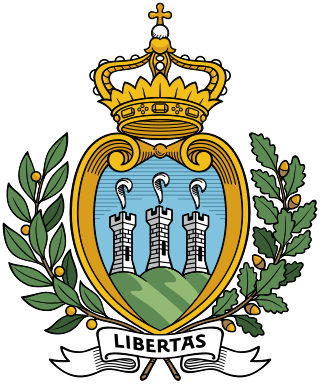
San Marino elects on the national level a legislature. The Grand and General Council has 60 members, elected for a five-year term by semi-proportional representation with national majority bonus.

The Grand and General Council is the parliament of San Marino. The council has 60 members elected for a five-year term.

General elections were held in Italy on 16 November 1919. The fragmented Liberal governing coalition lost the absolute majority in the Chamber of Deputies, due to the success of the Italian Socialist Party and the Italian People's Party.

Parliamentary elections were held in Russia on 12 December 1993. They were the first parliamentary elections in post-Soviet Russia and the only time to the Federation Council, with future members appointed by provincial legislatures and governors.

Full general elections were held in Belgium on 14 October 1894, with run-off elections held on 21 October 1894.

An abrogative referendum on the electoral law was held in Italy on 18 April 1999. Voters were asked whether they approved of replacing the mixed-member proportional representation electoral system with one based solely on single-member constituencies, with the 25% of seats instead allocated to the second-placed in the constituencies with the most votes. The proposal was supported by larger parties, but opposed by smaller ones. Although the proposal was approved by 92% of voters, turnout was only 49.58%, resulting in the referendum being invalidated as the threshold of 50% was not passed.
Parliamentary elections were held in Iceland on 27 October 1923. Voters elected all 28 seats in the Lower House of the Althing and eight of the fourteen seats in Upper House. The Citizens' Party, a loose collection of conservatives, emerged as the largest party in the Lower House, winning 16 of the 28 seats.

General elections were held in San Marino on 10 June 1906.

General elections were held in San Marino on 19 June 1909 to elect the second term of the Grand and General Council.

General elections were held in San Marino on 23 June 1912 to elect the third term of the Grand and General Council.

General elections were held in San Marino on 13 June 1915 to elect the fourth term of the Grand and General Council.

General elections were held in San Marino on 9 June 1918 to elect the fifth term of the Grand and General Council.

General elections were held in San Marino on 4 March 1923 to elect the seventh term of the Grand and General Council. It was a snap election that marked the beginning of fascist rule in the republic. Left-wing parties were prevented from participating, while all centre-right forces ran as a single "Patriotic Bloc". Of the 60 seats, 29 were taken by the Sammarinese Fascist Party, 20 by the Sammarinese People's Party, 9 by the Sammarinese Democratic Union and two by the Fascist-puppets Volunteers of War. Later the country was taken over by the Fascist Party.

General elections were held in San Marino on 12 December 1926 to elect the eighth term of the Grand and General Council. It was a sham election, all opposition being prevented to participate by internal and Italian threats. After it had taken over the country in April 1923, the Sammarinese Fascist Party was the only party to contest the elections, winning all 60 seats, while the official report spoke of a sole dissident ballot. A new electoral law guaranteed safe undisputed seats to the two incumbent Captains Regents.

General elections were held in San Marino on 5 September 1943. After the former ruling party, the Sammarinese Fascist Party had been dissolved on 28 July, the "Lista Unica" was formed by a coalition of political leaders and non-partisans. It won all 60 seats.

General elections were held in San Marino on 14 August 1955. Although the Sammarinese Christian Democratic Party remained the largest party, winning 23 of the 60 seats in the Grand and General Council, the alliance of the Sammarinese Communist Party and Sammarinese Socialist Party retained its majority.

General elections were held in San Marino on 7 September 1969. The Sammarinese Christian Democratic Party remained the largest party, winning 27 of the 60 seats in the Grand and General Council, and formed a coalition with the Independent Democratic Socialist Party, together holding 38 of the 60 seats. The Christian Democratic Party had flown in 400 supporters from the United States to vote for them.
The Sammarinese People's Party (PPS) was a Christian democratic political party in San Marino, forerunner of the current Sammarinese Christian Democratic Party, and counterpart of the Italian People's Party.
The Sammarinese Democratic Union was a conservative political movement in San Marino and a counterpart of the liberal coalition which ruled Italy before the fascist era.

General elections were held in San Marino on 8 December 2019.







